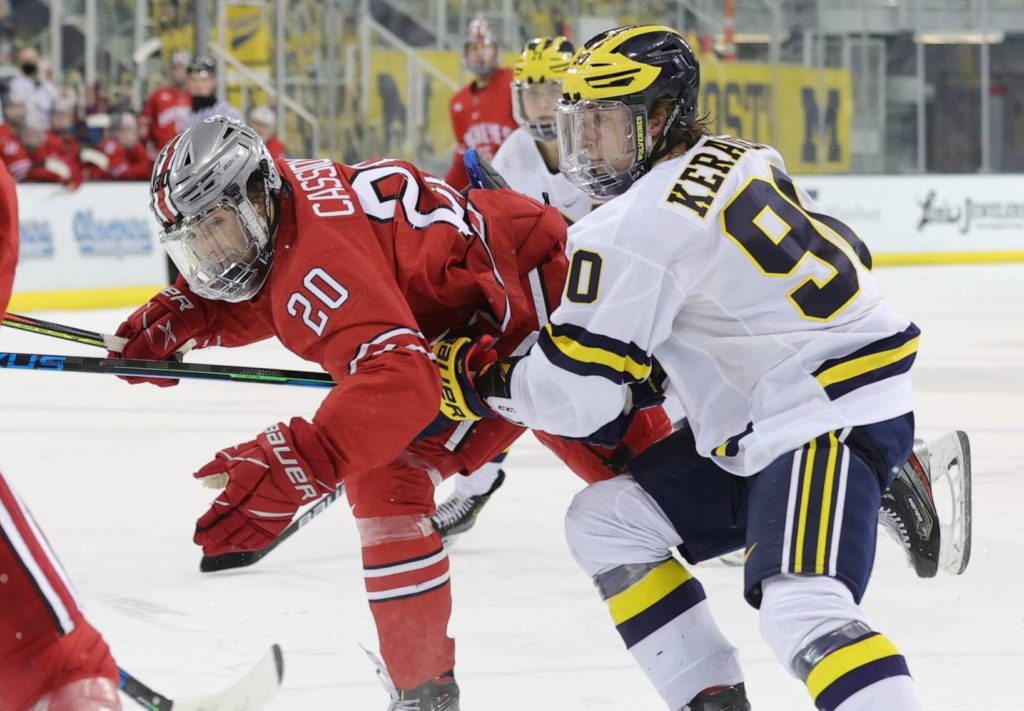
Are we there yet?
It’s a valid question, given how long this COVID-compressed season has felt, given how easily the season could have been derailed, given the intensity of competition that’s taken place in mostly empty arenas.
As each team in the Big Ten prepares for the three-day, single-elimination playoff championship tournament that begins March 14, a picture of a unified, almost defiant conference emerges along with snapshots of the unique, specific experiences that define each team in the league.
First, the unity
In Zoom press conferences with each coach this week, there was a lot of praise for how the Big Ten itself handled this pandemic season, beginning with the league’s foresight about what might have transpired.
“The Big Ten did an outstanding job of being the first conference to be up and running,” said Wisconsin’s Tony Granato. “All of our athletic departments went out of their way to keep our assets because there were lots of players who had different options of places to go play, whether it be professionally or moving on to different leagues.
“All of our programs, for the most part, were able to keep all of our players, and I think that’s going to really pay dividends down the road the next couple of years.”
Those dividends are paying off now.
All it takes is a look at the number of professional-caliber players in the Big Ten this week as the regular season ends to appreciate the conference’s commitment to hockey this season.
There’s the returning core of the Wisconsin team that went from last-place in 2019-20 to regular-season champs this year. There’s Michigan’s impossible-to-overrate freshman class. Eight Big Ten players brought home gold medals when Team USA won its fifth-ever gold in the IIHF World Juniors, and a ninth player – Wisconsin sophomore Dylan Holloway – earned a silver medal with Team Canada.
“There have been some teams in college hockey that have lost some of those players,” said Granato. “I think the respect our conference gained as a conference for how we did it will only continue to get the best players to come to our schools.”
Ohio State coach Steve Rohlik credited his own athletic director, Gene Smith, for getting all the balls rolling – so to speak – last summer.
“To me, if it wasn’t for Gene Smith and what he’s done here, even back with football when it was basically Ohio State and Nebraska fighting for football, if Gene Smith didn’t get out there and do what he did, if we didn’t have football, none of us would be on this call today. And that’s 100 percent for sure,” Rohlik said.
“Kudos to Gene, kudos to our administration and to all the Big Ten to fight to give these athletes a chance. I think that’s something you’ve got to hang your hat on and feel pretty good about, that we have had the opportunity to play games.”
Danton Cole at Michigan State implied that the move to a single site for the playoff tournament is a reflection of how everything came together this season.
“I think getting us all together, I think there’s been a lot of work done this year as far as the head coaches and the sports administrators,” said Cole. “The success that the Big Ten and college hockey has had overall this year has been outstanding. If you look at any other sports in the Big Ten, the number [of games] that we’ve got completed percentage-wise is pretty high.”
The consensus among a coaching fraternity that was already tight before the global pandemic threatened to wipe out more than just a college hockey season is that the Big Ten did things right, that administrations and staffs did things right, and that each team did all it could to get to this point.
But even though each coach feels part of a story bigger than his own team, each team’s experience this season was unique – and it may take years before we learn all about it.
”People don’t understand,” said Rohlik. “I think there’s one thing that’s 100 percent for sure, and that’s this pandemic has affected everybody. There’s no question. But the pandemic has affected every team differently and no one will really understand exactly what you go through unless you’re in that locker room, unless you’re within the team, the players, the coaches. What my group’s gone through might be a lot different than other guys.”
Now, the snapshots
The Buckeyes, for example, are a team that went from having the 13th-best defense in the nation last year to No. 45 this season, a team that went to the Frozen Four in 2018 and is finishing 2020-21 with six conference wins. Ohio State experienced big veteran turnover in the last two seasons, but Rohlik points to a lack of consistency this year, too.
“For us, it could be period to period,” said Rohlik. “Lately, it can be one game to the next. Let’s hope we catch ourselves on the right night.”
The Spartans are a team that everyone sees as continuing to prove under Cole’s tenure, but Michigan still finished the season in last place. Cole said of the results “it is what it is” and that the program will “sort all of that out,” but that there are things in play that cannot be defined – good things like “how people come through, how they do mentally, how they stick together, how they’ve battled, how they’ve seen some tough times and how they’re working through this right now.”
Said Cole, “By the end of the year, I always end up loving the teams I have, and I know the sacrifices they go through. Everybody doesn’t [know]. They don’t know the injuries and what everyone’s gone through, but we see it every day, so I’ve been impressed with them and they’ve made it. That hasn’t resulted in the number of wins they’ve wanted, but it rarely does.”
In fourth place, Notre Dame is having a tough time putting a full game together.
“We’ve had stretches where we’ve played really well, then, you know, we come down a notch,” said Fighting Irish coach Jeff Jackson. “I think we’ve been playing well, at times real well, and then we have a tendency to back off.
“I’d say that we’ve gotten better in the last several weeks in that area, but it’s still a concern of mine just being able to play the full 60 minutes at a high level. Hopefully going into the playoffs, we’ll have that sense of urgency to play three full periods, maybe even more.”
For Minnesota, it was watching a regular-season championship slip away. The Golden Gophers led the conference until the final two weeks of the season. Needing a win and a tie in the final weekend of the season, Minnesota split a series with Michigan.
And for the entirety of the season, the Gophers have been playing with an eye toward the national tournament after spending the second half of last year’s truncated campaign working their way toward a berth. When the Minnesota women’s team wasn’t selected as one of the eight teams heading to the NCAA championship tournament for the first time since 2007, the men began to think about their own chances.
The Gophers look like a lock on paper and coach Bob Motzko clearly didn’t want to talk about it when asked this week, but it’s not something easily ignored.
“We’re putting ourselves in a good spot, but our whole focus for our week is to get ready for the Big Ten tournament,” said Motzko. “Does that loom out there? Yeah. Crazier things have happened. We’re just getting ready to play Michigan State right now.”
The team that overtook the Gophers to win the regular-season title has had more than its share of obstacles along the way, not the least of which was recovering from a seven-win season in 2019-20.
“The confidence that they’ve had after coming off a horrendous season, I can’t say how difficult that is,” said Granato. “You don’t do it without great character kids and without great leadership from within your locker room. The feeling that it was going in the right direction, from the opening game at Notre Dame, you could sense something different and it’s carried on through really tough, tough situations.
“You go down and lose five players at one time, you lose Dylan [Holloway] for 10 games, you play four games with 15 players. Different things have happened that have been really challenging. We haven’t flinched.”
Not even through two COVID-19 pauses.
The two teams affected most recently by COVID pauses, though, are third-place Michigan and fifth-place Penn State.
The Wolverines lost two weeks when the entire University of Michigan athletic department was put on hold because of a local surge in COVID cases. Officials from Washtenaw County asked the school to shut everything sports-related down, and even though no one from the hockey program tested positive, that meant quarantining at home for two solid weeks.
Mel Pearson said that heading into the Big Ten tournament, the Wolverines still aren’t where they were before they were forced to take a break, as evidenced by their split against Minnesota last weekend.
“We were good offensively,” said Pearson. “We did some great things offensively, moving the puck, creating great opportunities going to the net, but defensively, we weren’t very good at times and that’s where the disconnect is right now and that scares me a bit.
“Before, I felt we were playing lights-out defensively. You might look at the scores and say, well, we only gave up two goals in the one night – and we’re sitting on two goals against a game, which is really good – but too many chances against. The goalies have had to bail us out too much recently, and we’ve been inconsistent. No, I don’t think we’re all the way back yet.”
For Penn State, a very long break because of COVID couldn’t have come at a worse time. The Nittany Lions didn’t play a single game for the entire month of February. Their first series of the month was postponed – and then cancelled – because they were scheduled to play Michigan and the Wolverines were out. That meant that at least Penn State could practice and keep conditioning.
Then the Nittany Lions were hit with their own COVID woes as multiple Tier 1 individuals – people directly involved with the team, such as players, coaches, trainers and other staff – tested positive for the novel coronavirus. Last weekend was the Nittany Lions’ first competition since and they dropped two games to Notre Dame.
“The amount of time off was one factor,” said Penn State coach Guy Gadowsky. “But the fact that our guys were not able to do anything when they had that time off is another.”
The Nittany Lions were the 2019-20 regular-season Big Ten champions. Penn State finishes this season with seven conference wins.
Finally, there’s gratitude – and a little knocking on wood
From the start of the season, Gadowsky has been frank about how difficult he’s found it to coach during the pandemic, citing everything from virtual meetings with players to the extra necessary precautions that can be difficult to track. This week, he said he still can’t wrap his head around all of it.
“I’m struggling with it myself, what to learn from this,” Gadowsky said. “I want to learn as much as we can, but boy, I’m not sure what that is yet.”
But he’s grateful to have made it this far, to be able to take his team to a tournament this weekend.
“We get a chance to compete, we get a chance to go to the Big Ten tournament and at this point, I’ll take it,” said Gadowsky.
“It’s a privilege to be able to compete, it’s a privilege to be able to play for a championship. It really is. There are programs that we see right now that have announced that they won’t have that opportunity and there’s other programs that already from the start of the year don’t have that opportunity. We’re very fortunate that we’ve been able to compete this season and we’ve gone through some challenges here lately, but we’re still able to get a chance to participate in the tournament, so we look at that as a real privilege.”
This was another sentiment that echoed through the individual Zoom conferences, as strong as the sense that the league had come together as a whole to preserve a season and, it appeared, just as unifying.
“I give my guys a ton of credit for what they’ve done, and again to give themselves opportunities to play within the year [and] to have a chance to go to a Big Ten tournament,” said Rohlik.
“We’ve still got a few days to get there, and every team’s holding their breath, right? Things can change just on a dime like that. We all can see that throughout college hockey and any other sport, there’s cancellations left and right. It goes back to what my guys have gone through and yet we’re very thankful for this opportunity.”
“It’s been a grind,” said Pearson. “I don’t think people realize the grind that it’s been, not only on the ice, but just the COVID situation and everything. We had a guy get tested this weekend again because he had a false positive and it just sends shivers through your team.”
For every coach – for absolutely everyone – the games themselves cannot come soon enough.
“Hey, we’re not there yet,” said Motzko. “We’ve got to continue to watch our backs right now. It’s still out there. We call it the boogeyman. It’s still out there.”


